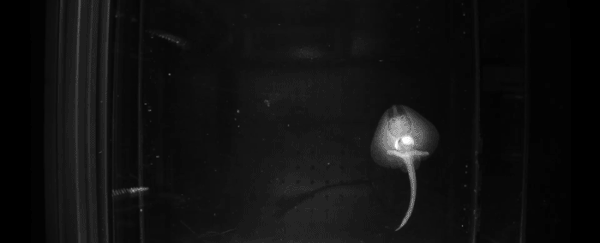The very first vertebrates to walk on our planet might have done so in the great ocean deep, millions of years before their later relatives transitioned to the land.
In 2018, scientists were shocked to find the little skate fish (Leucoraja erinacea) and some basal sharks were capable of footing it along the ocean floor using many of the same neural circuits that we use to walk today.
Generally, it's thought that vertebrates only learned to walk when they began to eschew the sea for the shore, roughly 380 million years ago. But further models based on the little skate fish - one of the most primitive animals with a backbone - suggest a much deeper origin, possibly more than 400 million years ago.
Using published video data on the scuttling dynamics of this benthic creature, mathematicians have developed a model to investigate how early leg-like motions might have evolved in the deep sea.
The simple model they have created predicts the most efficient, controlled, and balanced type of walking in a neutrally buoyant environment: The best result requires a left foot-right foot alternating pattern very similar to the little skate's waddle.
What's more, this type of trudging does not require any extra energetic cost and could be reinforced over time using a simple learning scheme.
"In the context of our model, these results suggest that, despite the vast solution space of gaits, a left-right alternating bipedal control strategy can and will be discovered and is the optimal solution for energy efficient locomotion," the study authors write.
Finding a real-world example of this ancient organism is akin to discovering a "needle in a haystack", the team admits, but they say only rudimentary legs would be needed to achieve this pattern of foot placement. After those feet-like fins evolved, the ancient creature would then have needed to gain only minimal neuronal control over their new and improved limbs.
After four episodes of learning in the model, a one-legged locomotion strategy began to emerge. After 200 episodes, a two-legged walking pattern took over. By the 600th episode, the modeled creature began to alternate between left and right steps.
Running roughly 50 instances of learning for 5,000 episodes, including various learning parameters and rewards, the authors found the best solution matches the little skate's walking gait in 70 percent of all cases.

This simple control strategy suggests walking in the deep sea is a robust and efficient behavior similar to passive walking, like the slinky toy that "walks" down a slope without the need for complex control, just gravity.
The little skate, of course, is not a completely passive plodder. Its brain cells still control six muscles for motion, but the authors say this system exploits the same principles as a passive one: "Sustained locomotion under a constant energy source without feedback control."
The authors aren't sure why the little skate developed a slow seafloor walk, but they suggest it is more efficient and cost-effective than swimming at a similar pace. Further metabolic studies on the deep sea creature will need to verify this idea.
Sometimes in the wild, the little skate will use both its legs at the same time to "punt" forward and quickly kick-start its left-right walking pattern. This sort of movement was not found in the model, but the authors think it might be favored when faster acceleration is needed and energy efficiency isn't as important. This unusual punt requires a bit more work.
"The combination of a reliable low gravity environment and a legged-body morphology may well have helped pave the way for bipedal gaits before our aquatic ancestors transitioned to terra firma," says applied mathematician Lakshminarayanan Mahadevan from Harvard University.
"As our ancient ancestors transitioned to land, the control strategy likely became more complex. But in reliably homogeneous environments, like the sea floor, perhaps a simple strategy was all that was needed."
To complement this theoretical model, researchers even built a simple bipedal robot based on similar deep sea conditions. In the end, the behavior of this robot showed striking similarities to their model's ideal walker. Its regular footstep pattern requires no extra energy and undulates on both sides of the body for stability.
The robot, however, tends to walk slightly faster than what is seen in the little skate.
The authors admit they may never know exactly how the first walking gait arose, but their model helps refine some of the passive dynamics and neural circuits seen in living organisms.
"Understanding how the brain, body and environment worked together in heterogeneous aquatic and terrestrial environments likely needed to include proprioceptive feedback," the authors suggest.
"But in reliably homogeneous environments, perhaps the simple strategy quantified here was where it all started."
The study was published in the Journal of the Royal Society Interface.
